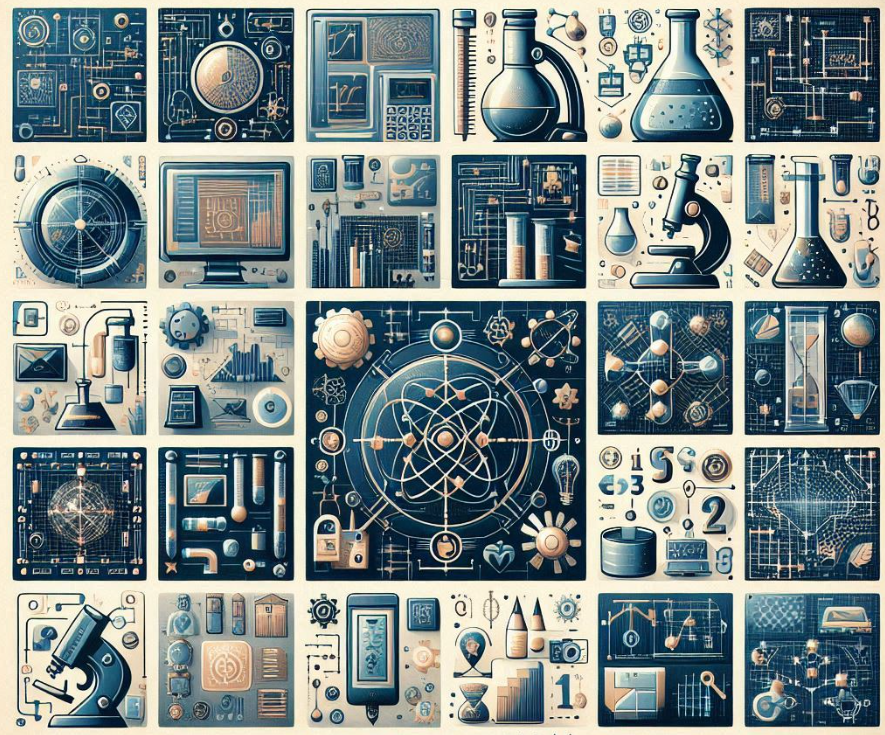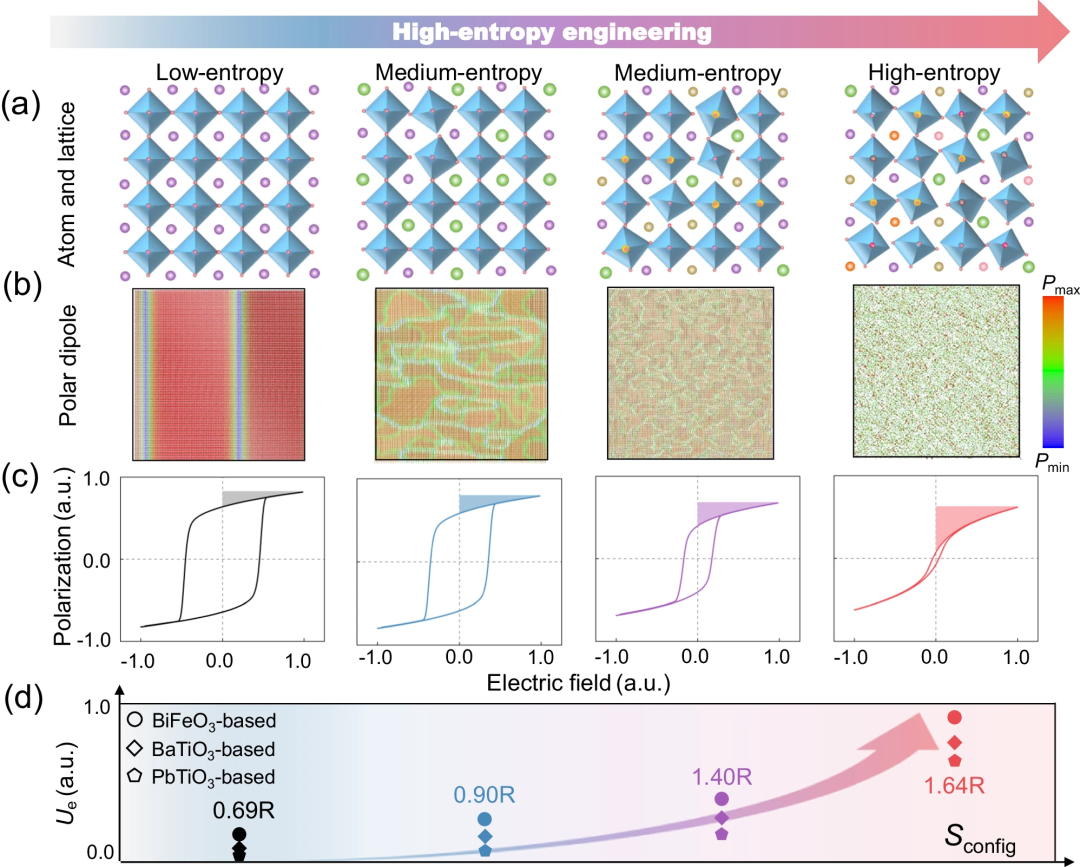
Editor | Radish skin dielectric materials can store and release charges and are widely used in capacitors, electronics and power systems. Due to their extremely high power density and fast response characteristics, they are used in fields such as hybrid electric vehicles, portable electronic devices and pulse power systems, but their energy density still needs to be further improved. High-entropy strategies have become an effective method to improve energy storage performance. However, discovering new high-entropy systems in high-dimensional composition spaces is a huge challenge for traditional trial-and-error experiments. Based on phase field simulations and limited experimental data, research teams from Wuhan University of Technology, Tsinghua University, and Pennsylvania State University proposed a generative learning method to accelerate the discovery of high-level learning in an infinite exploration space of more than
10^11combinations. Entropic dielectric materials (HED). This work provides an effective and innovative way to design high-entropy dielectric materials, significantly reducing the experimental cycle. The research was titled "Generative learning facilitated discovery of high-entropyceramic dielectrics for capacitive energy storage" and was published in "Nature Communications" on June 10, 2024.
Dielectric materials can store and release charges and are the core
component in capacitors. They are widely used in hybrid electric vehicles, portable electronic devices, and pulsed power systems due to their high power density and fast response characteristics. Additionally, dielectric materials are critical in modern electronic and power systems, supporting the  miniaturization
miniaturization
and high-efficiency operation of devices. However, traditional dielectric materials have limitations in energy density and thermal stability. The multi-entropy strategy can significantly improve these properties by introducing a variety of elements.
Illustration: Phase field simulation of the impact of configuration entropy (S
config) on energy storage performance. (Source: paper) High-entropy ceramics improve energy storage performance by forming diverse polarization structures with different valence states, ionic radii, and electronegativities, improving polarization response and breakdown strength. Currently, traditional experimental methods are inefficient and costly in discovering new high-entropy systems. To address these challenges, research teams from Tsinghua University, Wuhan University of Technology, and Pennsylvania State University built a generative learning-based framework based on small experimental data to accelerate the discovery of high energy density HED
. 
Illustration: Overview of the generative learning framework for high-entropy design. (Source: paper) In order to clarify the influence of configurational entropy on polarization response, the researchers performed phase field simulations to calculate the polarization-electric field (P-E) loop and corresponding energy density of HEDs with different entropy values. The results show that as the entropy value increases, the polarization region becomes more neutral and the energy density increases significantly. As an experimental example, the team selected Bi(Mg0.5Ti0.5)O3 (BMT) as the original matrix and designed the HED by simultaneously doping its A-site and B-site with multiple elements. Using 77 sets of experimental results as initial data, the researchers established a generative learning model based on encoding-decoding architecture, and combined data reconstruction and artificial neural network (ANN) to find potential optimal high-entropy combinations. Illustration: phase
structure and electrical property analysis. (Source: paper) Then perform probability sampling on the existing small sample data, retain two decimal places for the element content of positions A and B, and set the sum of each position to 1 to construct a possibility of close to 10^11 combinations.
and electrical property analysis. (Source: paper) Then perform probability sampling on the existing small sample data, retain two decimal places for the element content of positions A and B, and set the sum of each position to 1 to construct a possibility of close to 10^11 combinations.
space
, looking for the optimal
combination that satisfies the high entropy criterion. Then, the top five combinations with predicted results were screened from more than 2,000 candidate materials, and five sets of targeted experiments were conducted to verify their potential in energy storage performance.  Graphic: Energy storage performance and cycle stability. (Source: Paper) Experimental results show that the prepared high-entropy ceramic dielectric film is significantly better than traditional materials in terms of energy density and breakdown strength, especially the C-3 film under the electric field of 5104 kV/cm The energy density reaches 156 J/cm^3, which is eight times that of the original BMT (~18 J/cm^3) film. In addition, the study also explored the effects of different annealing temperatures on the performance of high-entropy films, and found that appropriate annealing temperatures can further improve the energy storage performance of the material. In summary, high-entropy films not only have excellent fatigue performance and temperature and frequency stability, but also show great potential for widespread applications in energy storage capacitors. Based on a machine learning-driven paradigm, the team leveraged very sparse experimental data to efficiently find the desired high-entropy composites with high energy storage properties. The method also allows researchers to significantly shorten the overall experimental cycle and opens up new avenues for designing material systems with complex components. Paper link: https://www.nature.com/articles/s41467-024-49170-8
Graphic: Energy storage performance and cycle stability. (Source: Paper) Experimental results show that the prepared high-entropy ceramic dielectric film is significantly better than traditional materials in terms of energy density and breakdown strength, especially the C-3 film under the electric field of 5104 kV/cm The energy density reaches 156 J/cm^3, which is eight times that of the original BMT (~18 J/cm^3) film. In addition, the study also explored the effects of different annealing temperatures on the performance of high-entropy films, and found that appropriate annealing temperatures can further improve the energy storage performance of the material. In summary, high-entropy films not only have excellent fatigue performance and temperature and frequency stability, but also show great potential for widespread applications in energy storage capacitors. Based on a machine learning-driven paradigm, the team leveraged very sparse experimental data to efficiently find the desired high-entropy composites with high energy storage properties. The method also allows researchers to significantly shorten the overall experimental cycle and opens up new avenues for designing material systems with complex components. Paper link: https://www.nature.com/articles/s41467-024-49170-8
The above is the detailed content of Eight times stronger than the original material, teams from Tsinghua University and Wuhan Institute of Technology used AI to screen high-entropy dielectric materials. For more information, please follow other related articles on the PHP Chinese website!


 miniaturization
miniaturization
 and electrical property analysis. (Source: paper) Then perform probability sampling on the existing small sample data, retain two decimal places for the element content of positions A and B, and set the sum of each position to 1 to construct a possibility of close to 10^11 combinations.
and electrical property analysis. (Source: paper) Then perform probability sampling on the existing small sample data, retain two decimal places for the element content of positions A and B, and set the sum of each position to 1 to construct a possibility of close to 10^11 combinations.  Graphic: Energy storage performance and cycle stability. (Source: Paper) Experimental results show that the prepared high-entropy ceramic dielectric film is significantly better than traditional materials in terms of energy density and breakdown strength, especially the C-3 film under the electric field of 5104 kV/cm The energy density reaches 156 J/cm^3, which is eight times that of the original BMT (~18 J/cm^3) film. In addition, the study also explored the effects of different annealing temperatures on the performance of high-entropy films, and found that appropriate annealing temperatures can further improve the energy storage performance of the material. In summary, high-entropy films not only have excellent fatigue performance and temperature and frequency stability, but also show great potential for widespread applications in energy storage capacitors. Based on a machine learning-driven paradigm, the team leveraged very sparse experimental data to efficiently find the desired high-entropy composites with high energy storage properties. The method also allows researchers to significantly shorten the overall experimental cycle and opens up new avenues for designing material systems with complex components. Paper link: https://www.nature.com/articles/s41467-024-49170-8
Graphic: Energy storage performance and cycle stability. (Source: Paper) Experimental results show that the prepared high-entropy ceramic dielectric film is significantly better than traditional materials in terms of energy density and breakdown strength, especially the C-3 film under the electric field of 5104 kV/cm The energy density reaches 156 J/cm^3, which is eight times that of the original BMT (~18 J/cm^3) film. In addition, the study also explored the effects of different annealing temperatures on the performance of high-entropy films, and found that appropriate annealing temperatures can further improve the energy storage performance of the material. In summary, high-entropy films not only have excellent fatigue performance and temperature and frequency stability, but also show great potential for widespread applications in energy storage capacitors. Based on a machine learning-driven paradigm, the team leveraged very sparse experimental data to efficiently find the desired high-entropy composites with high energy storage properties. The method also allows researchers to significantly shorten the overall experimental cycle and opens up new avenues for designing material systems with complex components. Paper link: https://www.nature.com/articles/s41467-024-49170-8 



